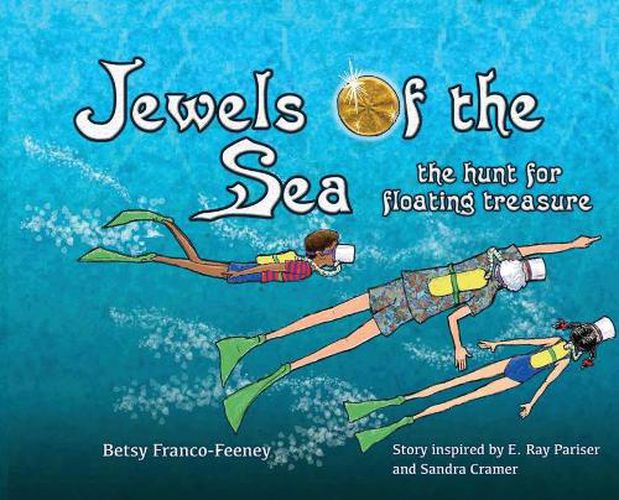Readings Newsletter
Become a Readings Member to make your shopping experience even easier.
Sign in or sign up for free!
You’re not far away from qualifying for FREE standard shipping within Australia
You’ve qualified for FREE standard shipping within Australia
The cart is loading…






This title is printed to order. This book may have been self-published. If so, we cannot guarantee the quality of the content. In the main most books will have gone through the editing process however some may not. We therefore suggest that you be aware of this before ordering this book. If in doubt check either the author or publisher’s details as we are unable to accept any returns unless they are faulty. Please contact us if you have any questions.
A scuba-diving grandpa introduces readers to the world of microscopic life in the sea in this children’s science book. The world’s oceans and freshwater environments teem with beneficial microscopic organisms called diatoms. Jewels of the Sea is sure to spark a sense of discovery in grade school-age readers as they are introduced to these creatures and to the essential roles they play in the aquatic food chain, medicine, biomedical research, industry, and the very health of the planet. In the first half of the book … Bart and his sister, Amy, go scuba diving with their grandfather Saba. He promises to show them the jewels of the sea -not a pirate’s treasure, as they hope at first, but a rainbow of diatoms so tiny they can be seen only through a microscope or the special micro-goggles Saba has invented. As the siblings exclaim over the glasslike diatoms, Saba’s facts about the organisms include how they provide the world with almost a quarter of all the oxygen we breathe through their process of photosynthesis. Saba’s oxygen-gathering machine allows for a visit to the ocean floor, where dead diatoms, forming a substance called diatomaceous earth, contribute to life, too. (Young readers’ jaws may drop when they learn that this substance, found in such prosaic products as cat litter and toothpaste, was used centuries ago in building the pyramids.) The more substantial second half of the book, intended for adults to experience with children, expands on this information in captivating detail. Finding, collecting, and viewing diatoms through a microscope are illustrated. Photographs add visual appeal to a clear presentation of astonishing diatom facts. The real-life science adventure ends with a comprehensive glossary of words and terms, a bibliography, source material conveniently identified by where it is referenced in the book, and a note about the inclusion of diatom images shot by multi-award-winning microphotographer Wim van Egmond. The final page of the book has a QR code artistically placed in the center of a colorful frustule montage which links to many book-related topics and hands-on projects like making your own plankton net to gather diatoms.
$9.00 standard shipping within Australia
FREE standard shipping within Australia for orders over $100.00
Express & International shipping calculated at checkout
This title is printed to order. This book may have been self-published. If so, we cannot guarantee the quality of the content. In the main most books will have gone through the editing process however some may not. We therefore suggest that you be aware of this before ordering this book. If in doubt check either the author or publisher’s details as we are unable to accept any returns unless they are faulty. Please contact us if you have any questions.
A scuba-diving grandpa introduces readers to the world of microscopic life in the sea in this children’s science book. The world’s oceans and freshwater environments teem with beneficial microscopic organisms called diatoms. Jewels of the Sea is sure to spark a sense of discovery in grade school-age readers as they are introduced to these creatures and to the essential roles they play in the aquatic food chain, medicine, biomedical research, industry, and the very health of the planet. In the first half of the book … Bart and his sister, Amy, go scuba diving with their grandfather Saba. He promises to show them the jewels of the sea -not a pirate’s treasure, as they hope at first, but a rainbow of diatoms so tiny they can be seen only through a microscope or the special micro-goggles Saba has invented. As the siblings exclaim over the glasslike diatoms, Saba’s facts about the organisms include how they provide the world with almost a quarter of all the oxygen we breathe through their process of photosynthesis. Saba’s oxygen-gathering machine allows for a visit to the ocean floor, where dead diatoms, forming a substance called diatomaceous earth, contribute to life, too. (Young readers’ jaws may drop when they learn that this substance, found in such prosaic products as cat litter and toothpaste, was used centuries ago in building the pyramids.) The more substantial second half of the book, intended for adults to experience with children, expands on this information in captivating detail. Finding, collecting, and viewing diatoms through a microscope are illustrated. Photographs add visual appeal to a clear presentation of astonishing diatom facts. The real-life science adventure ends with a comprehensive glossary of words and terms, a bibliography, source material conveniently identified by where it is referenced in the book, and a note about the inclusion of diatom images shot by multi-award-winning microphotographer Wim van Egmond. The final page of the book has a QR code artistically placed in the center of a colorful frustule montage which links to many book-related topics and hands-on projects like making your own plankton net to gather diatoms.